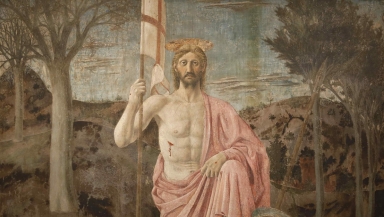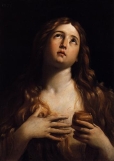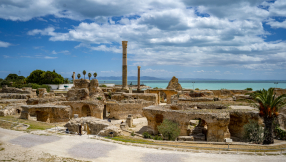
An Italian Renaissance masterpiece that English novelist Aldous Huxley once described as "the greatest picture in the world" was saved from destruction in World War Two by a British artillery officer who defied orders to shell the town.
Today, Piero della Francesca's 15th Century fresco of the resurrection of Jesus Christ on a wall in the Tuscan town of Sansepolcro is again in danger, and those trying to save it are again taking matters into their own hands.
Centuries of grime and humidity have wrought their damage, and the painting is flaking, cracking and discolored.
Austerity measures have dried up arts funding, so restorers have had to come up with an innovative scheme to blend private and state action to salvage the fresco. Aldo Osti, an Italian businessman now living in Switzerland who was once an executive at a multinational company based near the town, is funding half of the 200,000 euro cost of the two-year restoration.
It's the sort of philanthropy that is common in many countries but has long been rare in Italy, where the state considers itself the custodian of cultural patrimony.
Although emperors once gave their titles to the forums in Rome, contemporary Italian benefactors are discouraged from seeking civic glory by sponsoring cultural institutions.
But the Italian government's dire financial situation is forcing change, and the wealthy are increasingly being enlisted to help pay to keep up the country's artistic heritage.
Diego Della Valle, head of luxury leather goods company Tod's, is now helping to restore Rome's Colosseum. Officials stress that he will be rewarded only with a small plaque.
In the case of della Francesca's "The Resurrection", the entire renovation is still being carried out by the state, while Osti gets the privilege of helping pay for it.
Visitors will be able to watch restoration work from a specially built platform and follow it on a mobile phone app.
MOVING STORY
Della Francesca painted "The Resurrection" sometime between 1450 and 1465 on a wall of what was then the town hall, now a museum. It depicts a stern risen Christ on the edge of a sepulchre; the city's name means "holy sepulchre" in Italian.
The restored version may make the painting even more extraordinary than it appeared to Huxley: a recent, three-dimensional computer reconstruction using 20 non-invasive techniques including infrared imaging showed that dirt and decay had robbed the painting of much of its perspective.
During World War Two, British artillery officer Tony Clarke disobeyed orders to shell Sansepolcro because he had read a 1925 essay in which Huxley extolled the fresco.
Despite being under pressure from superiors, Clarke delayed long enough so that occupying German forces had retreated and shelling the city was no longer necessary. The locals responded by naming a street after him.
"This story about what Clarke did is a very moving one," said Cecilia Frosinini, head of the frescoes department at Italy's premier art restoration institute, Florence's Opificio delle Pietre Dure, which is carrying out the restoration, told Reuters.
"It was like a prophesy of what we are trying to do now. We too are trying to preserve works of art for future generations," she said during a private viewing ahead of the official unveiling of the restoration project later this month.
(Reuters)
















